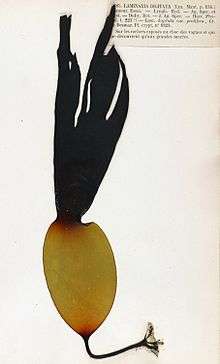Laminaria digitata
Laminaria digitata is a large brown alga in the family Laminariaceae, also known by the common name oarweed. It is found in the sublittoral zone of the northern Atlantic Ocean.
| Laminaria digitata | |
|---|---|
 | |
| Scientific classification | |
| Kingdom: | Chromista |
| Phylum: | Ochrophyta |
| Class: | Phaeophyceae |
| Order: | Laminariales |
| Family: | Laminariaceae |
| Genus: | Laminaria |
| Species: | L. digitata |
| Binomial name | |
| Laminaria digitata | |
Description

Laminaria digitata is a tough, leathery, dark brown seaweed that grows to two or three metres. The holdfast which anchors it to the rock is conical and has a number of spreading root-like protrusions called rhizoids. The stipe or stalk is flexible and oval in cross section and may be over 1 inch in diameter and grow to 5 feet in length.[1] The blade is large and shaped like the palm of a hand with a number of more or less regular finger-like segments. This seaweed can be distinguished from the rather similar Laminaria hyperborea by being darker in colour and having a shorter stipe that does not easily snap when bent.[2]
Reproduction
The life cycle is of the large diploid sporophytes and microscopic gametophytes. Spores develop in sori which occur over the central part of the blade.[3]
Distribution
Laminaria digitata occurs in the north west Atlantic from Greenland south to Cape Cod and in the north east Atlantic from northern Russia and Iceland south to France. It is common round the coasts of the British Isles except for much of the east coast of England.[2]
Ecology
Laminaria digitata is found mostly on exposed sites on shores in the lower littoral where it may form extensive meadows and can be the dominant algal species. It has a fairly high intrinsic growth rate compared to other algae, 5.5% per day, and a carrying capacity of about 40 kg wet weight per square meter. It may reach lengths of about 4 m. It overlaps to a small degree in distribution with Fucus serratus and Alaria esculenta. It is highly susceptible to grazing by sea urchins, among other species. It has low and high light limitation values of about 5 and 70 W per square meter respectively. Its distribution is also limited by salinity, wave exposure, temperature, desiccation and general stress. These and other attributes of the alga are summarized in the publications listed below.[4][5][6]
Uses
Laminaria digitata is harvested offshore of France and Morocco for use in manufacturing alginic acid.[7] It is used as an ingredient in some cosmetics.[8]
It was traditionally used as a fertiliser and spread on the land. In the 18th century it was burnt to extract the potash it contained for use in the glass industry. In the 19th century it was used for the extraction of iodine.[9]
Historically, the dried stalks of L digitata, called sea-tangle tents were used in traditional medicine an abortifacient[10] and for mechanically inducing labour.[11][12]
References
- Dickinson, C.I. 1963 British Seaweeds. The Kew Series,
- Laminaria digitata (Hudson) J.V. Lamouroux The Seaweed Site. Retrieved 2011-09-22.
- Bunker, F.StP.D., Maggs, C.A., Brodie, J.A. and Bunker A.R. 2017, Seaweeds of Britain and Ireland. Second Edition. Wild Nature Press, Plymouth, UK. ISBN 978-0-9955673-3-7
- Lewis, J.R.year=1964. The Ecology of Rocky Shores. English Universities Press, London.
- Seip, K.L. 1980. A mathematical model of competition and colonization in a community of marine benthic algae. Ecological modelling 10:77-104
- Seip, K.L. Mathematical models of rocky shore ecosystems. In Jørgensen, SE and Mitch, WJ (Eds) Application of ecological modelling in environmental management, Part B, Chap 13, pp 341-433
- Chapman, Valentine (2012). Seaweeds and their Uses. Springer Science & Business Media. ISBN 9789400958067.
- Pimentel, Filipa; Alves, Rita; Rodrigues, Francisca; P. P. Oliveira, M. (25 December 2017). "Macroalgae-Derived Ingredients for Cosmetic Industry—An Update". Cosmetics. 5 (1): 2. doi:10.3390/cosmetics5010002.

- Commercial Fertilizer and Plant Food Industry. W.W. Brown Publishing Company. 1914.
- Brookes, Barbara. "Isabel Annie Aves". Dictionary of New Zealand Biography. Ministry for Culture and Heritage. Retrieved 23 April 2017.
- Lawrence, Ghislaine (August 2002). "Laminaria tents". The Lancet. 360 (9331): 497. doi:10.1016/S0140-6736(02)09688-5.

- Jozwiak, M; Bloemenkamp, KW; Kelly, AJ; Mol, BW; Irion, O; Boulvain, M (14 March 2012). "Mechanical methods for induction of labour". The Cochrane Database of Systematic Reviews (3): CD001233. doi:10.1002/14651858.CD001233.pub2. PMID 22419277.